Professional Practice Report: Pearson BTEC HND Computing Unit 3
VerifiedAdded on 2021/08/23
|26
|6796
|213
Report
AI Summary
This report is a comprehensive professional practice assignment for a Pearson BTEC Level 5 HND Diploma in Computing, focusing on Unit 3: Professional Practice. It details a training event, including planning, resourcing, and the design and delivery of a workshop on team dynamics. The report includes an evaluation of interpersonal skills, problem-solving techniques, and critical reasoning applied to the event. It also examines learning styles, self-managed learning, lifelong learning, and time management. Furthermore, the assignment encompasses the creation of a personal development portfolio (PDP) outlining short-term and long-term objectives, as well as a discussion of Continuing Professional Development (CPD) and its role in the workplace. The assignment is assessed on various learning outcomes, including communication skills, critical reasoning, team dynamics, and the application of professional development principles.
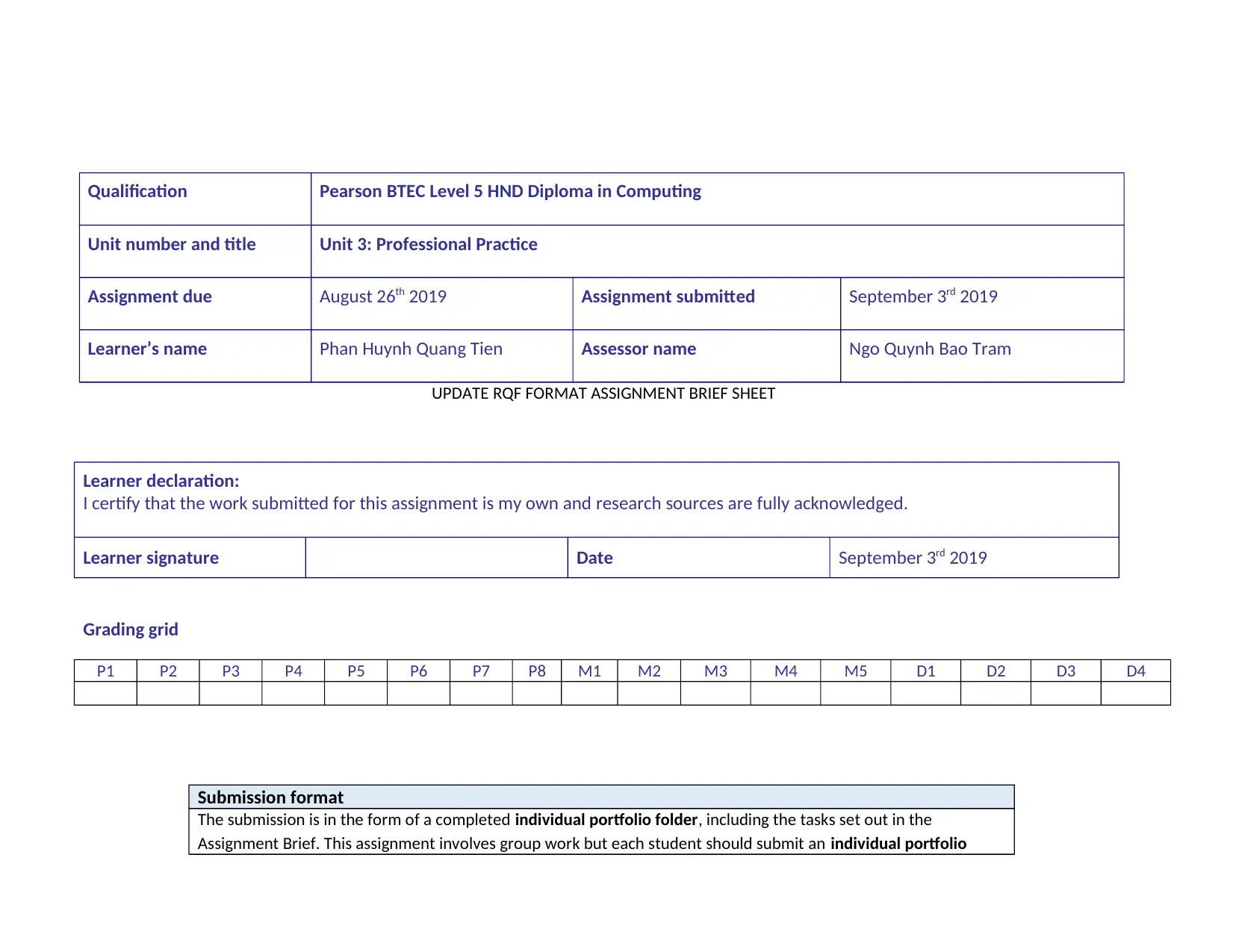
Qualification Pearson BTEC Level 5 HND Diploma in Computing
Unit number and title Unit 3: Professional Practice
Assignment due August 26th 2019 Assignment submitted September 3rd 2019
Learner’s name Phan Huynh Quang Tien Assessor name Ngo Quynh Bao Tram
UPDATE RQF FORMAT ASSIGNMENT BRIEF SHEET
Learner declaration:
I certify that the work submitted for this assignment is my own and research sources are fully acknowledged.
Learner signature Date September 3rd 2019
Grading grid
P1 P2 P3 P4 P5 P6 P7 P8 M1 M2 M3 M4 M5 D1 D2 D3 D4
Submission format
The submission is in the form of a completed individual portfolio folder, including the tasks set out in the
Assignment Brief. This assignment involves group work but each student should submit an individual portfolio
Unit number and title Unit 3: Professional Practice
Assignment due August 26th 2019 Assignment submitted September 3rd 2019
Learner’s name Phan Huynh Quang Tien Assessor name Ngo Quynh Bao Tram
UPDATE RQF FORMAT ASSIGNMENT BRIEF SHEET
Learner declaration:
I certify that the work submitted for this assignment is my own and research sources are fully acknowledged.
Learner signature Date September 3rd 2019
Grading grid
P1 P2 P3 P4 P5 P6 P7 P8 M1 M2 M3 M4 M5 D1 D2 D3 D4
Submission format
The submission is in the form of a completed individual portfolio folder, including the tasks set out in the
Assignment Brief. This assignment involves group work but each student should submit an individual portfolio
Paraphrase This Document
Need a fresh take? Get an instant paraphrase of this document with our AI Paraphraser
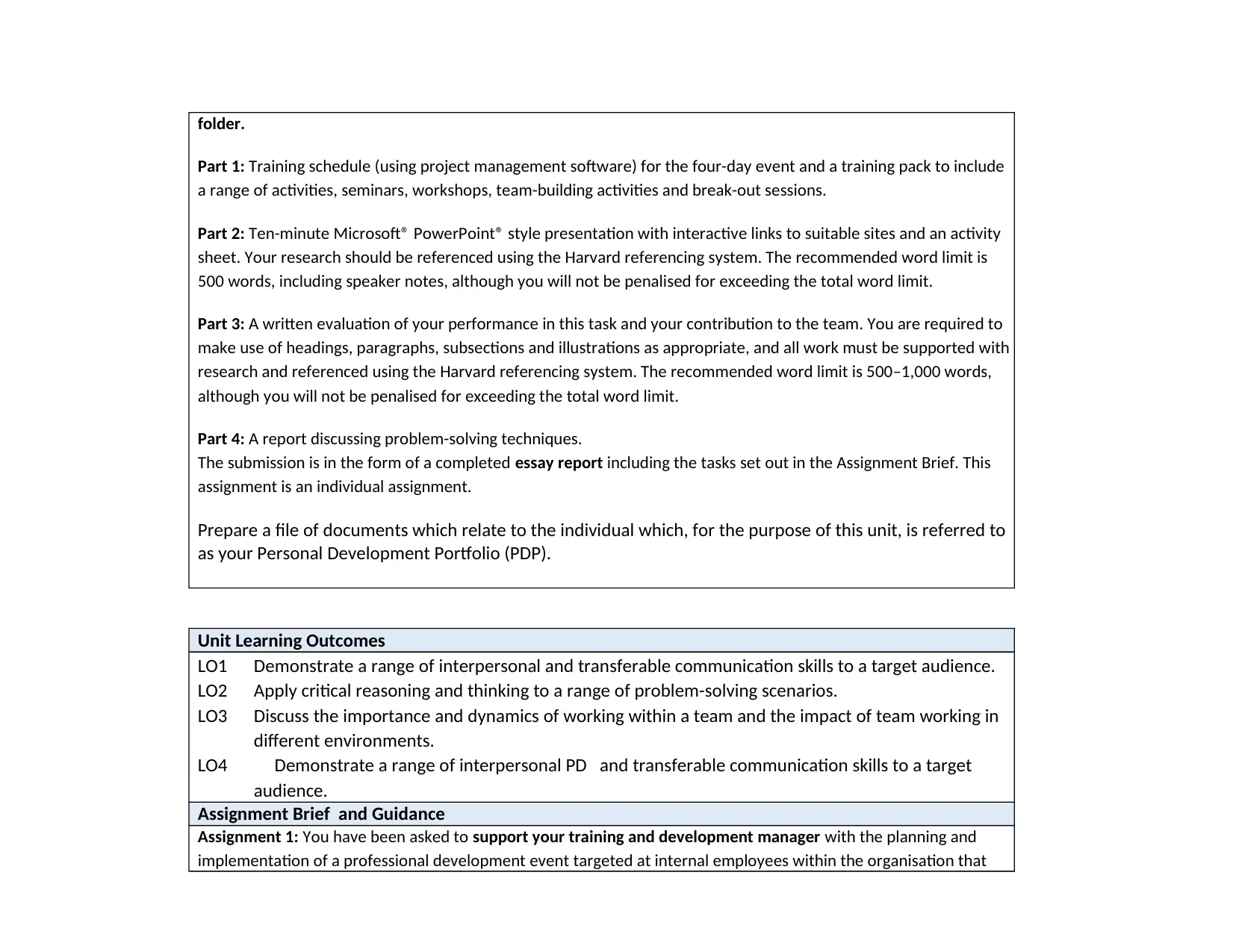
folder.
Part 1: Training schedule (using project management software) for the four-day event and a training pack to include
a range of activities, seminars, workshops, team-building activities and break-out sessions.
Part 2: Ten-minute Microsoft® PowerPoint® style presentation with interactive links to suitable sites and an activity
sheet. Your research should be referenced using the Harvard referencing system. The recommended word limit is
500 words, including speaker notes, although you will not be penalised for exceeding the total word limit.
Part 3: A written evaluation of your performance in this task and your contribution to the team. You are required to
make use of headings, paragraphs, subsections and illustrations as appropriate, and all work must be supported with
research and referenced using the Harvard referencing system. The recommended word limit is 500–1,000 words,
although you will not be penalised for exceeding the total word limit.
Part 4: A report discussing problem-solving techniques.
The submission is in the form of a completed essay report including the tasks set out in the Assignment Brief. This
assignment is an individual assignment.
Prepare a file of documents which relate to the individual which, for the purpose of this unit, is referred to
as your Personal Development Portfolio (PDP).
Unit Learning Outcomes
LO1 Demonstrate a range of interpersonal and transferable communication skills to a target audience.
LO2 Apply critical reasoning and thinking to a range of problem-solving scenarios.
LO3 Discuss the importance and dynamics of working within a team and the impact of team working in
different environments.
LO4 Demonstrate a range of interpersonal PD and transferable communication skills to a target
audience.
Assignment Brief and Guidance
Assignment 1: You have been asked to support your training and development manager with the planning and
implementation of a professional development event targeted at internal employees within the organisation that
Part 1: Training schedule (using project management software) for the four-day event and a training pack to include
a range of activities, seminars, workshops, team-building activities and break-out sessions.
Part 2: Ten-minute Microsoft® PowerPoint® style presentation with interactive links to suitable sites and an activity
sheet. Your research should be referenced using the Harvard referencing system. The recommended word limit is
500 words, including speaker notes, although you will not be penalised for exceeding the total word limit.
Part 3: A written evaluation of your performance in this task and your contribution to the team. You are required to
make use of headings, paragraphs, subsections and illustrations as appropriate, and all work must be supported with
research and referenced using the Harvard referencing system. The recommended word limit is 500–1,000 words,
although you will not be penalised for exceeding the total word limit.
Part 4: A report discussing problem-solving techniques.
The submission is in the form of a completed essay report including the tasks set out in the Assignment Brief. This
assignment is an individual assignment.
Prepare a file of documents which relate to the individual which, for the purpose of this unit, is referred to
as your Personal Development Portfolio (PDP).
Unit Learning Outcomes
LO1 Demonstrate a range of interpersonal and transferable communication skills to a target audience.
LO2 Apply critical reasoning and thinking to a range of problem-solving scenarios.
LO3 Discuss the importance and dynamics of working within a team and the impact of team working in
different environments.
LO4 Demonstrate a range of interpersonal PD and transferable communication skills to a target
audience.
Assignment Brief and Guidance
Assignment 1: You have been asked to support your training and development manager with the planning and
implementation of a professional development event targeted at internal employees within the organisation that
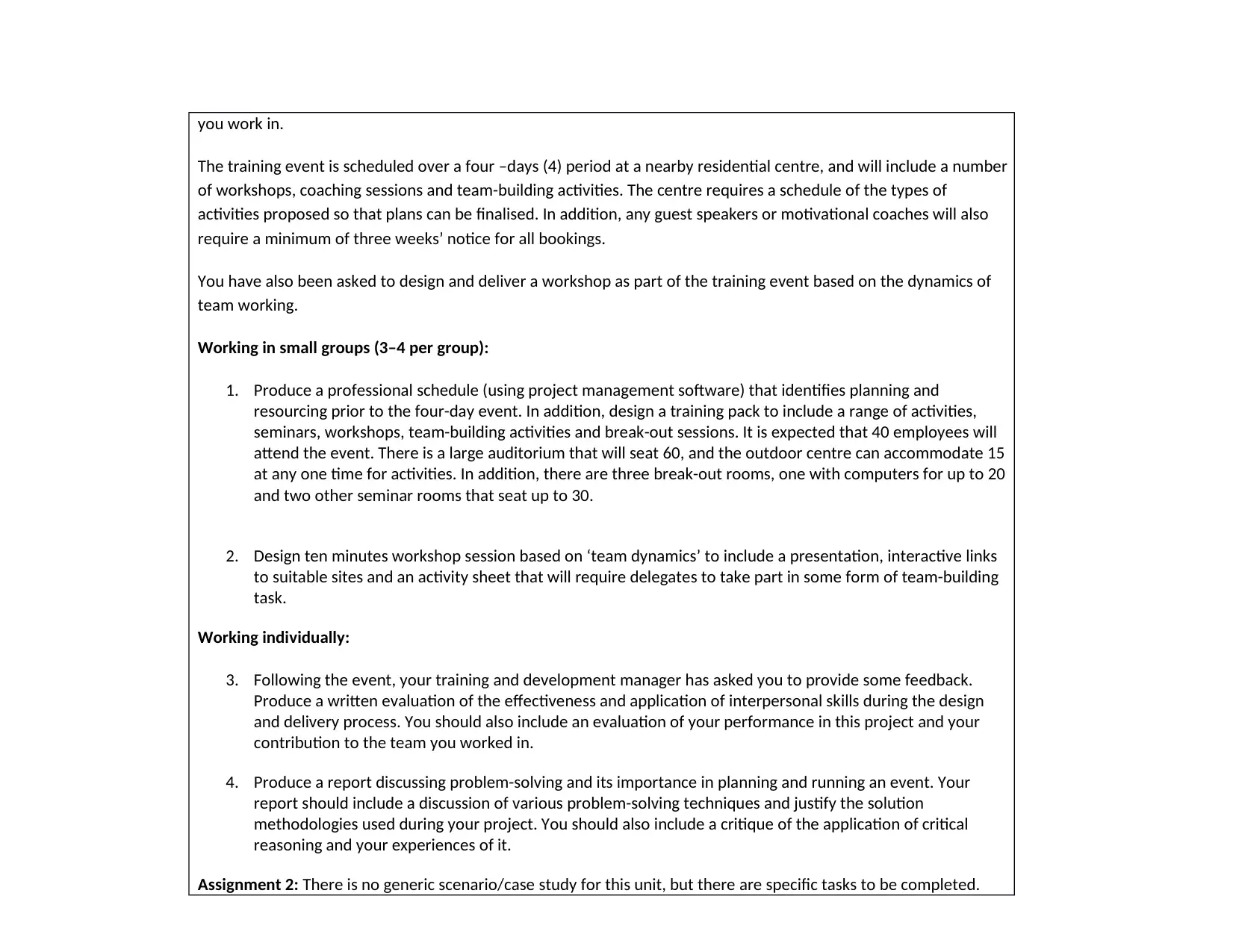
you work in.
The training event is scheduled over a four –days (4) period at a nearby residential centre, and will include a number
of workshops, coaching sessions and team-building activities. The centre requires a schedule of the types of
activities proposed so that plans can be finalised. In addition, any guest speakers or motivational coaches will also
require a minimum of three weeks’ notice for all bookings.
You have also been asked to design and deliver a workshop as part of the training event based on the dynamics of
team working.
Working in small groups (3–4 per group):
1. Produce a professional schedule (using project management software) that identifies planning and
resourcing prior to the four-day event. In addition, design a training pack to include a range of activities,
seminars, workshops, team-building activities and break-out sessions. It is expected that 40 employees will
attend the event. There is a large auditorium that will seat 60, and the outdoor centre can accommodate 15
at any one time for activities. In addition, there are three break-out rooms, one with computers for up to 20
and two other seminar rooms that seat up to 30.
2. Design ten minutes workshop session based on ‘team dynamics’ to include a presentation, interactive links
to suitable sites and an activity sheet that will require delegates to take part in some form of team-building
task.
Working individually:
3. Following the event, your training and development manager has asked you to provide some feedback.
Produce a written evaluation of the effectiveness and application of interpersonal skills during the design
and delivery process. You should also include an evaluation of your performance in this project and your
contribution to the team you worked in.
4. Produce a report discussing problem-solving and its importance in planning and running an event. Your
report should include a discussion of various problem-solving techniques and justify the solution
methodologies used during your project. You should also include a critique of the application of critical
reasoning and your experiences of it.
Assignment 2: There is no generic scenario/case study for this unit, but there are specific tasks to be completed.
The training event is scheduled over a four –days (4) period at a nearby residential centre, and will include a number
of workshops, coaching sessions and team-building activities. The centre requires a schedule of the types of
activities proposed so that plans can be finalised. In addition, any guest speakers or motivational coaches will also
require a minimum of three weeks’ notice for all bookings.
You have also been asked to design and deliver a workshop as part of the training event based on the dynamics of
team working.
Working in small groups (3–4 per group):
1. Produce a professional schedule (using project management software) that identifies planning and
resourcing prior to the four-day event. In addition, design a training pack to include a range of activities,
seminars, workshops, team-building activities and break-out sessions. It is expected that 40 employees will
attend the event. There is a large auditorium that will seat 60, and the outdoor centre can accommodate 15
at any one time for activities. In addition, there are three break-out rooms, one with computers for up to 20
and two other seminar rooms that seat up to 30.
2. Design ten minutes workshop session based on ‘team dynamics’ to include a presentation, interactive links
to suitable sites and an activity sheet that will require delegates to take part in some form of team-building
task.
Working individually:
3. Following the event, your training and development manager has asked you to provide some feedback.
Produce a written evaluation of the effectiveness and application of interpersonal skills during the design
and delivery process. You should also include an evaluation of your performance in this project and your
contribution to the team you worked in.
4. Produce a report discussing problem-solving and its importance in planning and running an event. Your
report should include a discussion of various problem-solving techniques and justify the solution
methodologies used during your project. You should also include a critique of the application of critical
reasoning and your experiences of it.
Assignment 2: There is no generic scenario/case study for this unit, but there are specific tasks to be completed.
⊘ This is a preview!⊘
Do you want full access?
Subscribe today to unlock all pages.

Trusted by 1+ million students worldwide

Students will examine different methods of learning, which will help them to identify their own preferred style of
learning. They will use this information as a basis for writing an essay about learning styles, self-managed learning,
the role of lifelong learning and, aspects of time management.
Students will also compile a personal portfolio of information about themselves, which will help them to identify
and achieve their personal goals.
You will be assessed on the quality of the information provided in this assignment. You should identify the above
issues clearly and present professionally in a report format. Yourself evaluation should be ‘SMART’ than a mere
description. You may analyse qualities of existing business entrepreneurs for you to carry out the self-evaluation.
Task
Discuss the learning styles which can be implemented to overcome the problems you have identified. You should
seek to communicate this information in an appropriate manner at various levels – strategic, tactical and operational
Identify one work based problem, either where you work now or where you intend to work in the future,
where the solution requires individual training or qualifications.
Your PDP should identify your short term objectives and long term objectives, together with the processes and
activities required to implement your development plan.
Learning Outcomes and Assessment Criteria
Pass Merit Distinction
LO1: Demonstrate a range of interpersonal and transferable communication skills to a target audience
learning. They will use this information as a basis for writing an essay about learning styles, self-managed learning,
the role of lifelong learning and, aspects of time management.
Students will also compile a personal portfolio of information about themselves, which will help them to identify
and achieve their personal goals.
You will be assessed on the quality of the information provided in this assignment. You should identify the above
issues clearly and present professionally in a report format. Yourself evaluation should be ‘SMART’ than a mere
description. You may analyse qualities of existing business entrepreneurs for you to carry out the self-evaluation.
Task
Discuss the learning styles which can be implemented to overcome the problems you have identified. You should
seek to communicate this information in an appropriate manner at various levels – strategic, tactical and operational
Identify one work based problem, either where you work now or where you intend to work in the future,
where the solution requires individual training or qualifications.
Your PDP should identify your short term objectives and long term objectives, together with the processes and
activities required to implement your development plan.
Learning Outcomes and Assessment Criteria
Pass Merit Distinction
LO1: Demonstrate a range of interpersonal and transferable communication skills to a target audience
Paraphrase This Document
Need a fresh take? Get an instant paraphrase of this document with our AI Paraphraser
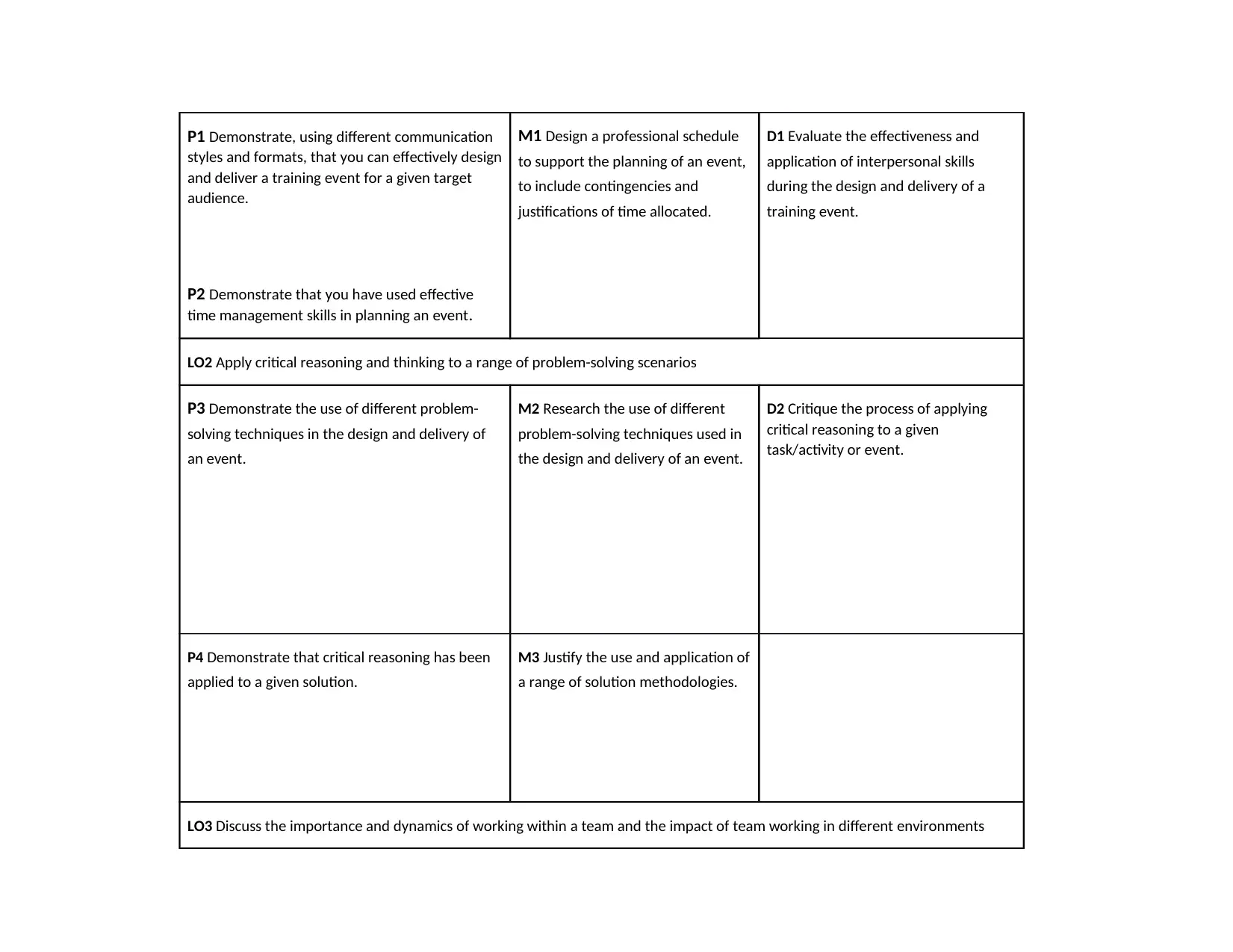
P1 Demonstrate, using different communication
styles and formats, that you can effectively design
and deliver a training event for a given target
audience.
P2 Demonstrate that you have used effective
time management skills in planning an event.
M1 Design a professional schedule
to support the planning of an event,
to include contingencies and
justifications of time allocated.
D1 Evaluate the effectiveness and
application of interpersonal skills
during the design and delivery of a
training event.
LO2 Apply critical reasoning and thinking to a range of problem-solving scenarios
P3 Demonstrate the use of different problem-
solving techniques in the design and delivery of
an event.
M2 Research the use of different
problem-solving techniques used in
the design and delivery of an event.
D2 Critique the process of applying
critical reasoning to a given
task/activity or event.
P4 Demonstrate that critical reasoning has been
applied to a given solution.
M3 Justify the use and application of
a range of solution methodologies.
LO3 Discuss the importance and dynamics of working within a team and the impact of team working in different environments
styles and formats, that you can effectively design
and deliver a training event for a given target
audience.
P2 Demonstrate that you have used effective
time management skills in planning an event.
M1 Design a professional schedule
to support the planning of an event,
to include contingencies and
justifications of time allocated.
D1 Evaluate the effectiveness and
application of interpersonal skills
during the design and delivery of a
training event.
LO2 Apply critical reasoning and thinking to a range of problem-solving scenarios
P3 Demonstrate the use of different problem-
solving techniques in the design and delivery of
an event.
M2 Research the use of different
problem-solving techniques used in
the design and delivery of an event.
D2 Critique the process of applying
critical reasoning to a given
task/activity or event.
P4 Demonstrate that critical reasoning has been
applied to a given solution.
M3 Justify the use and application of
a range of solution methodologies.
LO3 Discuss the importance and dynamics of working within a team and the impact of team working in different environments
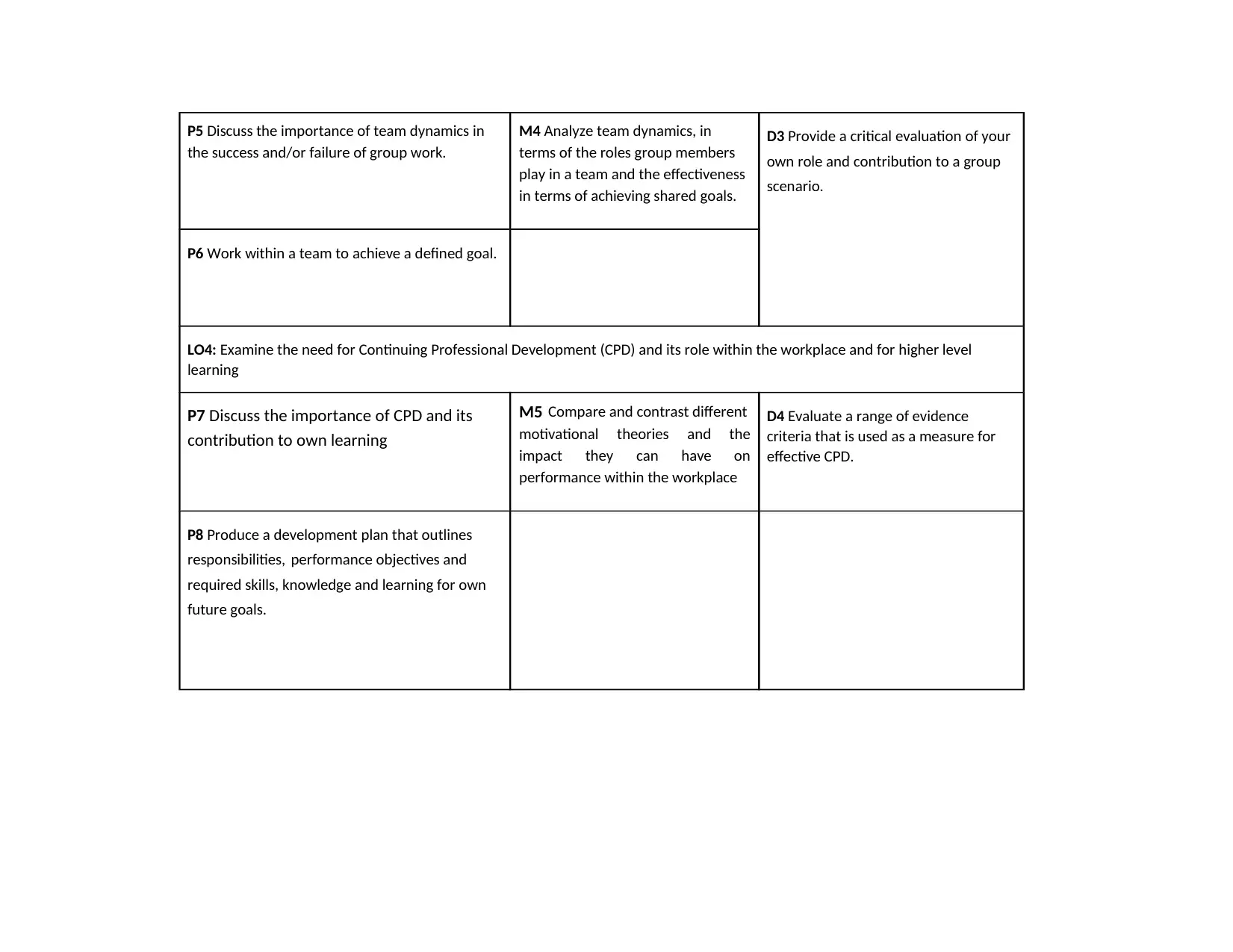
P5 Discuss the importance of team dynamics in
the success and/or failure of group work.
M4 Analyze team dynamics, in
terms of the roles group members
play in a team and the effectiveness
in terms of achieving shared goals.
D3 Provide a critical evaluation of your
own role and contribution to a group
scenario.
P6 Work within a team to achieve a defined goal.
LO4: Examine the need for Continuing Professional Development (CPD) and its role within the workplace and for higher level
learning
P7 Discuss the importance of CPD and its
contribution to own learning
M5 Compare and contrast different
motivational theories and the
impact they can have on
performance within the workplace
D4 Evaluate a range of evidence
criteria that is used as a measure for
effective CPD.
P8 Produce a development plan that outlines
responsibilities, performance objectives and
required skills, knowledge and learning for own
future goals.
the success and/or failure of group work.
M4 Analyze team dynamics, in
terms of the roles group members
play in a team and the effectiveness
in terms of achieving shared goals.
D3 Provide a critical evaluation of your
own role and contribution to a group
scenario.
P6 Work within a team to achieve a defined goal.
LO4: Examine the need for Continuing Professional Development (CPD) and its role within the workplace and for higher level
learning
P7 Discuss the importance of CPD and its
contribution to own learning
M5 Compare and contrast different
motivational theories and the
impact they can have on
performance within the workplace
D4 Evaluate a range of evidence
criteria that is used as a measure for
effective CPD.
P8 Produce a development plan that outlines
responsibilities, performance objectives and
required skills, knowledge and learning for own
future goals.
⊘ This is a preview!⊘
Do you want full access?
Subscribe today to unlock all pages.

Trusted by 1+ million students worldwide
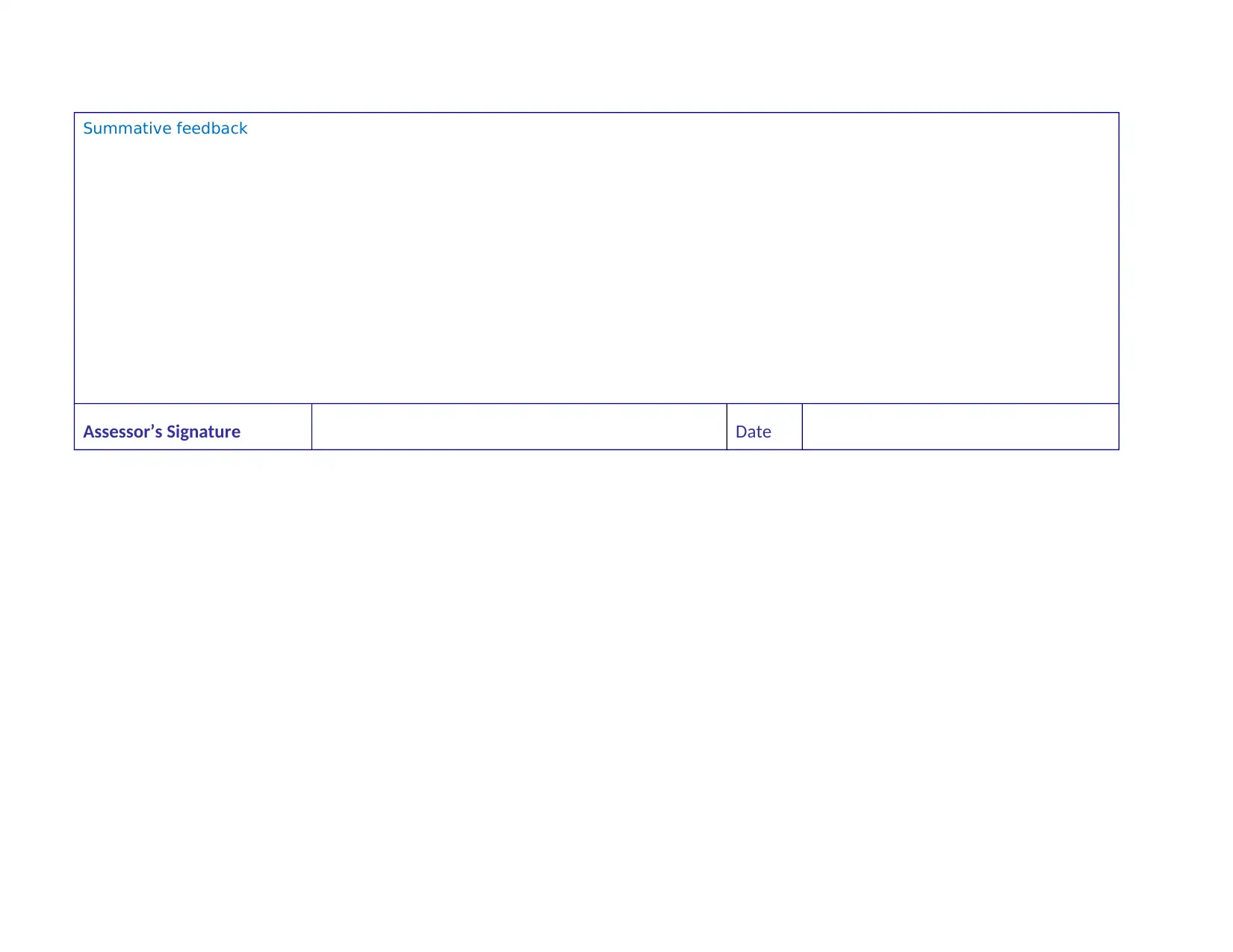
Summative feedback
Assessor’s Signature Date
Assessor’s Signature Date
Paraphrase This Document
Need a fresh take? Get an instant paraphrase of this document with our AI Paraphraser

<ATTACHED EVIDENCE>

⊘ This is a preview!⊘
Do you want full access?
Subscribe today to unlock all pages.

Trusted by 1+ million students worldwide
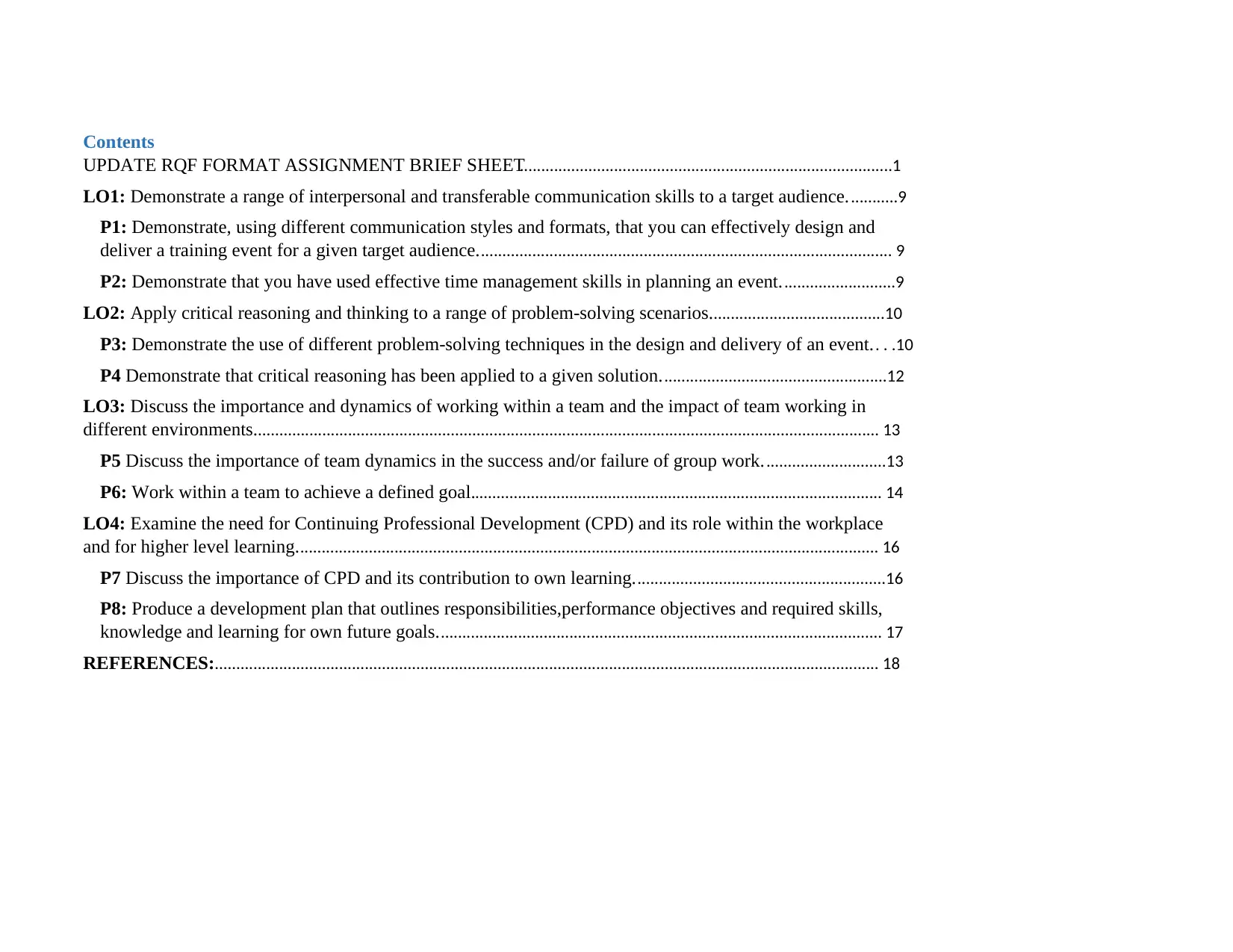
Contents
UPDATE RQF FORMAT ASSIGNMENT BRIEF SHEET.......................................................................................1
LO1: Demonstrate a range of interpersonal and transferable communication skills to a target audience............9
P1: Demonstrate, using different communication styles and formats, that you can effectively design and
deliver a training event for a given target audience................................................................................................. 9
P2: Demonstrate that you have used effective time management skills in planning an event...........................9
LO2: Apply critical reasoning and thinking to a range of problem-solving scenarios.........................................10
P3: Demonstrate the use of different problem-solving techniques in the design and delivery of an event.. . .10
P4 Demonstrate that critical reasoning has been applied to a given solution.....................................................12
LO3: Discuss the importance and dynamics of working within a team and the impact of team working in
different environments.................................................................................................................................................. 13
P5 Discuss the importance of team dynamics in the success and/or failure of group work.............................13
P6: Work within a team to achieve a defined goal................................................................................................ 14
LO4: Examine the need for Continuing Professional Development (CPD) and its role within the workplace
and for higher level learning........................................................................................................................................ 16
P7 Discuss the importance of CPD and its contribution to own learning...........................................................16
P8: Produce a development plan that outlines responsibilities,performance objectives and required skills,
knowledge and learning for own future goals........................................................................................................ 17
REFERENCES:........................................................................................................................................................... 18
UPDATE RQF FORMAT ASSIGNMENT BRIEF SHEET.......................................................................................1
LO1: Demonstrate a range of interpersonal and transferable communication skills to a target audience............9
P1: Demonstrate, using different communication styles and formats, that you can effectively design and
deliver a training event for a given target audience................................................................................................. 9
P2: Demonstrate that you have used effective time management skills in planning an event...........................9
LO2: Apply critical reasoning and thinking to a range of problem-solving scenarios.........................................10
P3: Demonstrate the use of different problem-solving techniques in the design and delivery of an event.. . .10
P4 Demonstrate that critical reasoning has been applied to a given solution.....................................................12
LO3: Discuss the importance and dynamics of working within a team and the impact of team working in
different environments.................................................................................................................................................. 13
P5 Discuss the importance of team dynamics in the success and/or failure of group work.............................13
P6: Work within a team to achieve a defined goal................................................................................................ 14
LO4: Examine the need for Continuing Professional Development (CPD) and its role within the workplace
and for higher level learning........................................................................................................................................ 16
P7 Discuss the importance of CPD and its contribution to own learning...........................................................16
P8: Produce a development plan that outlines responsibilities,performance objectives and required skills,
knowledge and learning for own future goals........................................................................................................ 17
REFERENCES:........................................................................................................................................................... 18
Paraphrase This Document
Need a fresh take? Get an instant paraphrase of this document with our AI Paraphraser
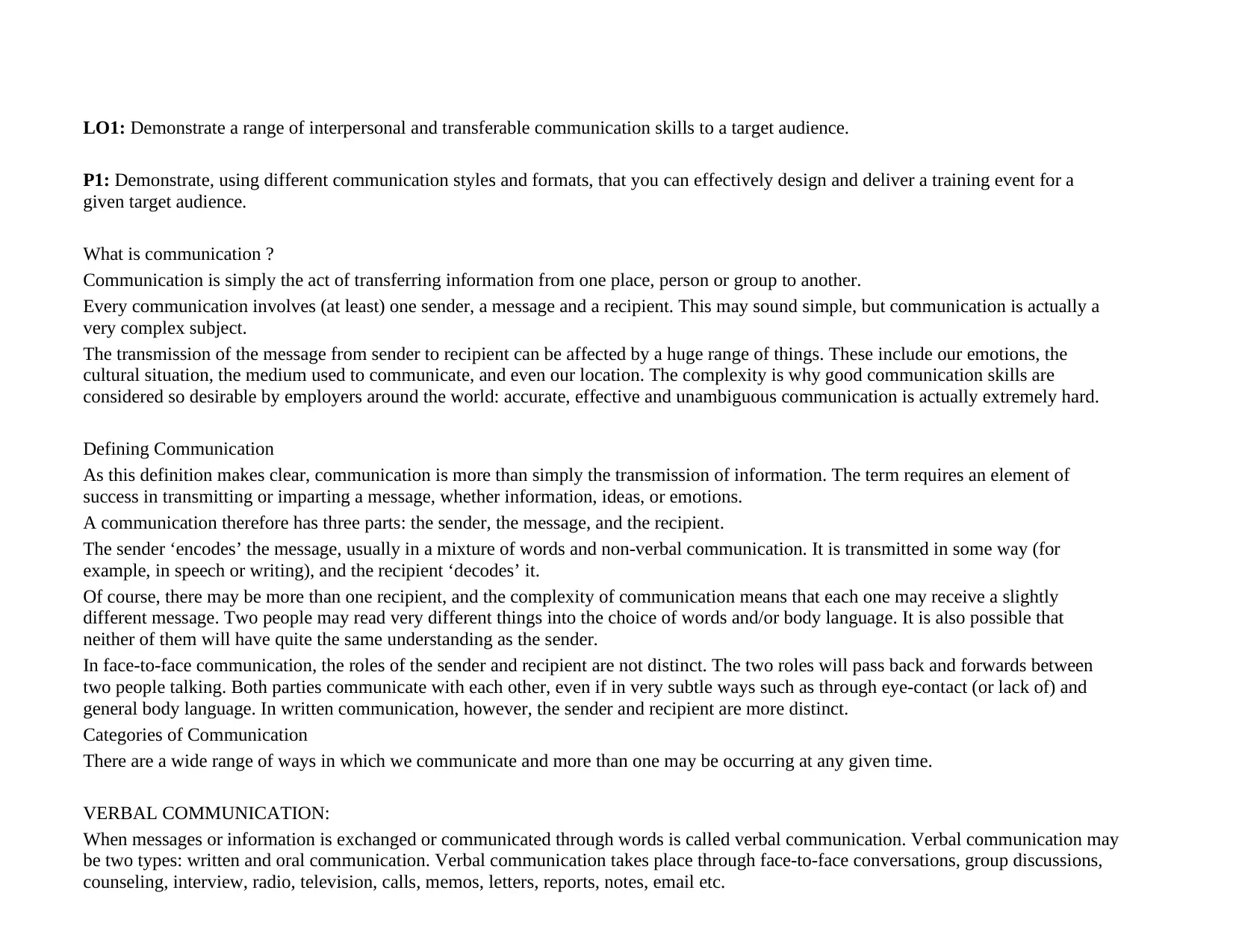
LO1: Demonstrate a range of interpersonal and transferable communication skills to a target audience.
P1: Demonstrate, using different communication styles and formats, that you can effectively design and deliver a training event for a
given target audience.
What is communication ?
Communication is simply the act of transferring information from one place, person or group to another.
Every communication involves (at least) one sender, a message and a recipient. This may sound simple, but communication is actually a
very complex subject.
The transmission of the message from sender to recipient can be affected by a huge range of things. These include our emotions, the
cultural situation, the medium used to communicate, and even our location. The complexity is why good communication skills are
considered so desirable by employers around the world: accurate, effective and unambiguous communication is actually extremely hard.
Defining Communication
As this definition makes clear, communication is more than simply the transmission of information. The term requires an element of
success in transmitting or imparting a message, whether information, ideas, or emotions.
A communication therefore has three parts: the sender, the message, and the recipient.
The sender ‘encodes’ the message, usually in a mixture of words and non-verbal communication. It is transmitted in some way (for
example, in speech or writing), and the recipient ‘decodes’ it.
Of course, there may be more than one recipient, and the complexity of communication means that each one may receive a slightly
different message. Two people may read very different things into the choice of words and/or body language. It is also possible that
neither of them will have quite the same understanding as the sender.
In face-to-face communication, the roles of the sender and recipient are not distinct. The two roles will pass back and forwards between
two people talking. Both parties communicate with each other, even if in very subtle ways such as through eye-contact (or lack of) and
general body language. In written communication, however, the sender and recipient are more distinct.
Categories of Communication
There are a wide range of ways in which we communicate and more than one may be occurring at any given time.
VERBAL COMMUNICATION:
When messages or information is exchanged or communicated through words is called verbal communication. Verbal communication may
be two types: written and oral communication. Verbal communication takes place through face-to-face conversations, group discussions,
counseling, interview, radio, television, calls, memos, letters, reports, notes, email etc.
P1: Demonstrate, using different communication styles and formats, that you can effectively design and deliver a training event for a
given target audience.
What is communication ?
Communication is simply the act of transferring information from one place, person or group to another.
Every communication involves (at least) one sender, a message and a recipient. This may sound simple, but communication is actually a
very complex subject.
The transmission of the message from sender to recipient can be affected by a huge range of things. These include our emotions, the
cultural situation, the medium used to communicate, and even our location. The complexity is why good communication skills are
considered so desirable by employers around the world: accurate, effective and unambiguous communication is actually extremely hard.
Defining Communication
As this definition makes clear, communication is more than simply the transmission of information. The term requires an element of
success in transmitting or imparting a message, whether information, ideas, or emotions.
A communication therefore has three parts: the sender, the message, and the recipient.
The sender ‘encodes’ the message, usually in a mixture of words and non-verbal communication. It is transmitted in some way (for
example, in speech or writing), and the recipient ‘decodes’ it.
Of course, there may be more than one recipient, and the complexity of communication means that each one may receive a slightly
different message. Two people may read very different things into the choice of words and/or body language. It is also possible that
neither of them will have quite the same understanding as the sender.
In face-to-face communication, the roles of the sender and recipient are not distinct. The two roles will pass back and forwards between
two people talking. Both parties communicate with each other, even if in very subtle ways such as through eye-contact (or lack of) and
general body language. In written communication, however, the sender and recipient are more distinct.
Categories of Communication
There are a wide range of ways in which we communicate and more than one may be occurring at any given time.
VERBAL COMMUNICATION:
When messages or information is exchanged or communicated through words is called verbal communication. Verbal communication may
be two types: written and oral communication. Verbal communication takes place through face-to-face conversations, group discussions,
counseling, interview, radio, television, calls, memos, letters, reports, notes, email etc.
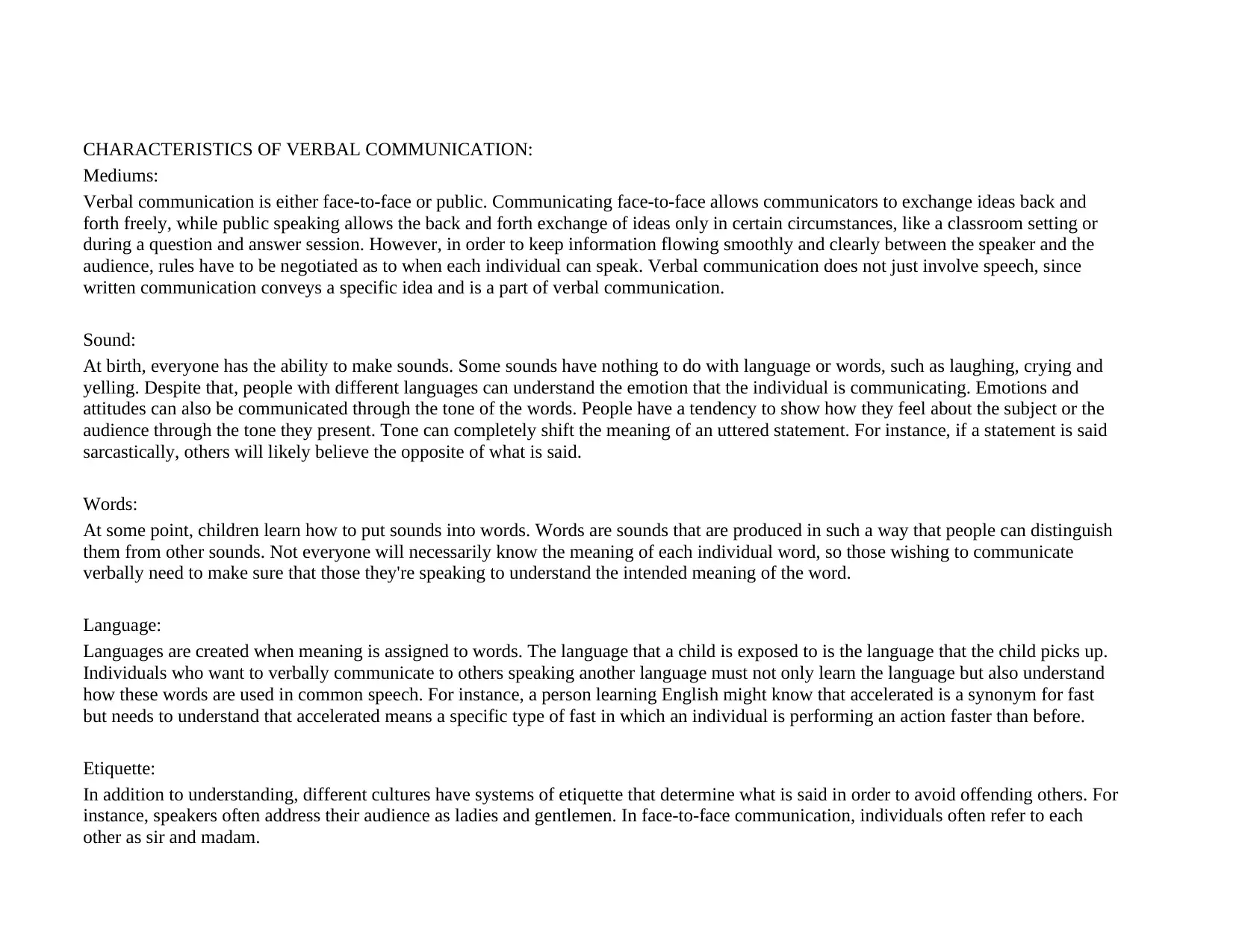
CHARACTERISTICS OF VERBAL COMMUNICATION:
Mediums:
Verbal communication is either face-to-face or public. Communicating face-to-face allows communicators to exchange ideas back and
forth freely, while public speaking allows the back and forth exchange of ideas only in certain circumstances, like a classroom setting or
during a question and answer session. However, in order to keep information flowing smoothly and clearly between the speaker and the
audience, rules have to be negotiated as to when each individual can speak. Verbal communication does not just involve speech, since
written communication conveys a specific idea and is a part of verbal communication.
Sound:
At birth, everyone has the ability to make sounds. Some sounds have nothing to do with language or words, such as laughing, crying and
yelling. Despite that, people with different languages can understand the emotion that the individual is communicating. Emotions and
attitudes can also be communicated through the tone of the words. People have a tendency to show how they feel about the subject or the
audience through the tone they present. Tone can completely shift the meaning of an uttered statement. For instance, if a statement is said
sarcastically, others will likely believe the opposite of what is said.
Words:
At some point, children learn how to put sounds into words. Words are sounds that are produced in such a way that people can distinguish
them from other sounds. Not everyone will necessarily know the meaning of each individual word, so those wishing to communicate
verbally need to make sure that those they're speaking to understand the intended meaning of the word.
Language:
Languages are created when meaning is assigned to words. The language that a child is exposed to is the language that the child picks up.
Individuals who want to verbally communicate to others speaking another language must not only learn the language but also understand
how these words are used in common speech. For instance, a person learning English might know that accelerated is a synonym for fast
but needs to understand that accelerated means a specific type of fast in which an individual is performing an action faster than before.
Etiquette:
In addition to understanding, different cultures have systems of etiquette that determine what is said in order to avoid offending others. For
instance, speakers often address their audience as ladies and gentlemen. In face-to-face communication, individuals often refer to each
other as sir and madam.
Mediums:
Verbal communication is either face-to-face or public. Communicating face-to-face allows communicators to exchange ideas back and
forth freely, while public speaking allows the back and forth exchange of ideas only in certain circumstances, like a classroom setting or
during a question and answer session. However, in order to keep information flowing smoothly and clearly between the speaker and the
audience, rules have to be negotiated as to when each individual can speak. Verbal communication does not just involve speech, since
written communication conveys a specific idea and is a part of verbal communication.
Sound:
At birth, everyone has the ability to make sounds. Some sounds have nothing to do with language or words, such as laughing, crying and
yelling. Despite that, people with different languages can understand the emotion that the individual is communicating. Emotions and
attitudes can also be communicated through the tone of the words. People have a tendency to show how they feel about the subject or the
audience through the tone they present. Tone can completely shift the meaning of an uttered statement. For instance, if a statement is said
sarcastically, others will likely believe the opposite of what is said.
Words:
At some point, children learn how to put sounds into words. Words are sounds that are produced in such a way that people can distinguish
them from other sounds. Not everyone will necessarily know the meaning of each individual word, so those wishing to communicate
verbally need to make sure that those they're speaking to understand the intended meaning of the word.
Language:
Languages are created when meaning is assigned to words. The language that a child is exposed to is the language that the child picks up.
Individuals who want to verbally communicate to others speaking another language must not only learn the language but also understand
how these words are used in common speech. For instance, a person learning English might know that accelerated is a synonym for fast
but needs to understand that accelerated means a specific type of fast in which an individual is performing an action faster than before.
Etiquette:
In addition to understanding, different cultures have systems of etiquette that determine what is said in order to avoid offending others. For
instance, speakers often address their audience as ladies and gentlemen. In face-to-face communication, individuals often refer to each
other as sir and madam.
⊘ This is a preview!⊘
Do you want full access?
Subscribe today to unlock all pages.

Trusted by 1+ million students worldwide
1 out of 26
Related Documents
Your All-in-One AI-Powered Toolkit for Academic Success.
+13062052269
info@desklib.com
Available 24*7 on WhatsApp / Email
![[object Object]](/_next/static/media/star-bottom.7253800d.svg)
Unlock your academic potential
Copyright © 2020–2025 A2Z Services. All Rights Reserved. Developed and managed by ZUCOL.





